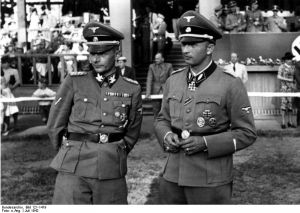Friedrich-Wilhelm Krüger
F. W. Krüger and Fegelein - Riding Tournament Warsaw July 1942
Friedrich- Wilhem Krüger was born on 8 May 1894 in Strassburg, Alsace. He was the son of Alfed Krüger who was a Colonel in the German Army, who was later killed in the First World War, after achieving the rank of a regimental commander. Friedrich-Wilhem attended but did not graduate from the Gymnasium in Rastatt. He attended military academies in Karlsruhe and Gross- Lichterfelde and was commissioned as a Lieutenant in March 1914. He fought in the First World War with the Infantry Regiment 'von Lutzow' serving as a platoon and company commander adjutant. In 1919 he became a staff officer with the 20th Infantry Division and from August 1919 until May 1920, he served in the Freikorps and won both classes of the Iron Cross and the Wound Badge in Silver, he left the army in 1920, after achieving the rank of Oberleutnant.
He became a businessman and joined the Nazi Party in mid-November 1920 and later he joined the SS in August 1930 and he served as a special duties officer with Abschnitt III from mid-March 1931 until January 1935. He joined the SA on 3 April 1931, as an SA-Gruppenfuhrer, and he served briefly as the Stabsfuhrer of SA Gruppe Ostland and then commanded the Gruppe until the start of July 1932. From July 1932 until July 1933 he was chief of the Special Duties Staff of the SA. He then commanded the training section and SA Border Units until August 1934, and was promoted to the rank of SA-Obergruppenfuhrer in 1934.Krüger returned to service in the SS on 25 January 1935 and was immediately promoted to SS-Obergruppenfuhrer and from March 1936 until October 1939 he commanded the SS Border Units and was also Inspector of the General SS -Mounted Units from May 1938 until October 1939. He was also a member of the Reichstag and held Berlin and Prussian state offices.
Following the invasion and occupation of Poland he was appointed by Heinrich Himmler, RFSS, to the post of SS and Police Leader for Lodz in October 1939. This however, was a short -lived appointment as a month later Himmler appointed him to the post of Higher SS and Police Leader East, based in Krakow, which was the seat of Hans Frank, the General Governor of the Generalgouvernement (Poland).Krüger was thus the most senior SS and Police commander, and as such was a leading figure in the measures carried out against the Jews and on the 19 July 1942, Himmler sent Krüger a secret directive from Berlin, which began with the words:
I herewith order that the resettlement of the entire Jewish population of the Generalgouvernement be carried out and completed by 31 December 1942
However, this deadline was not met and to make matters worse, the Jews in the Warsaw Ghetto rose up in revolt. Jurgen Stroop was brought in to replace the SS and Police Leader von Sammern-Frankenegg and crush the revolt. Stroop sent daily reports to Krüger in Krakow, and Stroop noted in his daily report for 2 May 1943, that Kruger himself visited the Warsaw Ghetto.
Krüger and Frank engaged in a power-struggle, which resulted in Krüger being replaced by Wilhelm Koppe, to the role of HSSP Ost during November 1943, and Krüger requested a transfer to a combat unit. He trained for the role of a Divisional Commander with the Prinz-Eugen, SS Division from November 1943 until April 1944, after a brief secondment to Himmler's personal staff. From May to August 1944, he led the 6 SS -Gebirgs Division 'Nord' and then commanded the SS-Freiwilligen- Gebirgs Korps until mid-February 1945. During the remainder of the war he was assigned to the HSSPF command area in East Prussia. He was awarded the Knights Cross on Himmler's personal recommendation on the 22 October 1944, for his command of the 'Nord Division.' Krüger committed suicide in Libau, Courland on the 9 May 1945.
Sources
Mark C Yeager, The Commands, Units and Leaders of the General SS, published by Schiffer Publishing Ltd 1997
Martin Gilbert, The Holocaust - The Jewish Tragedy, published by Collins, London 1986
Andrzej Wirth, The Stroop Report, published by Secker and Warburg, London 1980
Photograph - Bundesarchiv
© Holocaust Historical Society 2016


